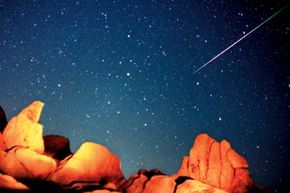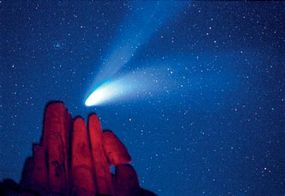And speaking of our moon . . . the number of planets in our solar system is almost nothing compared to the number and variety of moons that revolve around every planet except Mercury and Venus. Scientists think our moon may have been ripped from Earth in a gigantic collision billions of years ago.
Titan, the mega-moon that orbits Saturn, has its own atmosphere of nitrogen. It may also have lakes and possibly even its own continents. One of Jupiter's moons is the volcanic Io, whose surface is constantly being flexed by Jupiter's gravity. Another of Jupiter's moons is Europa, a striped ice moon. But scientists think it may have vast oceans underneath its icy crust.
Neptune's moon, Triton, has geysers of nitrogen spewing through a layer of nitrogen ice. Triton's pockmarked surface looks like the skin of a cantaloupe. In addition, it orbits Neptune in a backward direction called "retrograde," and may eventually spiral close enough to Neptune to be torn apart by the planet's gravity. Phobos, one of Mars's moons, may, millions of years from now, crash into the surface of the Red Planet.
The moons that orbit the planets in our solar system fall into two categories: icy or rocky. Rocky moons, as the name suggests, are moons made mostly of rocky material like our own moon. Icy moons are made mostly of ice, which can be frozen water, or ice made of other materials.
There are only eight planets in our solar system, but there are more than a hundred moons. Scientists believe that our moon and possibly other moons in the solar system were created when a large object such as an asteroid collided with the parent planet. Some may have been asteroids that got caught up in a planet's gravitation pull. Still other moons were probably formed from material left over when the planets were formed in the early days of the solar system. Saturn has moons that are part of its magnificent ring system.
Most moons have craters, which show that our early solar system was a crowded place with objects crashing into one another. The smaller object in the crash is usually destroyed, but the larger object is often left with a crater.
The asteroids, comets, stars, shooting stars, meteors, and moons make our solar system a beautiful and lively arena.

